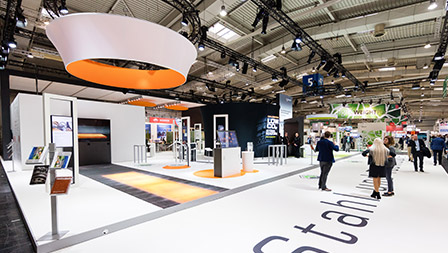The Salzgitter Group emerges from the trough in the second quarter of 2009
13.08.2009 | Salzgitter AG
The Salzgitter Group emerges from the trough in the second quarter of 2009
In accordance with expectations, the Salzgitter Group was exposed to considerable pressure from the impact of the global financial and economic crisis in the first half of the financial year 2009. This was reflected above all in the results of the Steel, Trading and Technology divisions. While the positive contributions made by the tubes product segments, the Aurubis AG holding, and extensive funds invested had a stabilizing counter-effect, they were unable to compensate for the negative influences of the economic environment.
The Group’s external sales contracted in almost all product segments, by 34 % to € 4,125.7 million (first half year of 2008: € 6,233.4 million), owing to significant declines in shipments and selling prices. In the first half-year, the Salzgitter Group recorded a pre-tax loss of € 195.2 million (first half of 2008: €+646.4 million). This result has absorbed significant accounting measures mainly in the Steel Division relating to adjustments to the value of inventories, along with other measures carried out in the 2008 financial statements, to ensure that the Group remains free from hidden inventory valuations burdens. The 23 % holding in the leading European copper producer Aurubis AG, a company consolidated at equity, contributed very satisfactory after-tax earnings of € 32.7 million. The consolidated after-tax result came to €–165.0 million (first half of 2008: €+436.9 million), which brings earnings per share to €–3.07. Return on capital employed (ROCE) from industrial business stood at –12.9 % (first half of 2008: +36.8 %); including around € 1.5 billion in cash and cash equivalents it came to –8.1 % (first half of 2008: +25.9 %).
In the first six months of 2009, the global recession had its strongest impact on the companies of the Steel Division. Capacity utilization in the Salzgitter and Peine mills, for instance, fell partly to around 50 % of capacity. The plate market also deteriorated towards the end of the first quarter, which caused capacity under-utilization at the Ilsenburg mill as well. The exorbitant plummeting of prices across all product groups, which only came to a halt in the summer, served to exacerbate the situation further. Consequently, external sales halved to € 799.9 million (first half of 2008: € 1,611.0 million). The falling price of raw materials was unable to ease the pressure on the half-yearly result attributable to initially higher levels of inventories bought at last year’s prices. Moreover, inventories held at the end of June were valued to insure that all significant down-valuation risks in the Steel division likely have been be accounted for. Including this burden, a pre-tax loss of € 190.2 million was recorded (first half year of 2008: € +345.1 million).
The challenging business situation has also hampered all activities in the Trading Division. The weak demand of many steel processors, compounded by huge destocking in the stockholding steel trade and the downturn in trading volume due to market conditions, caused external sales to decrease by 37 % to € 1,683.7 million (first half of 2008: € 2,656.4 million). The pre-tax result came to €–57.7 million (first half of 2008: €+140.7 million).
The Tubes Division delivered a distinct positive highlight thanks to the comparatively sound situation in the large-diameter, HFI-welded tubes and stainless steel tubes product segments. External sales improved by 3% to € 1,107.9 million (first half year of 2008: € 1,077.0 million) despite the unsatisfactory capacity utilization situation of the precision tubes companies. The division presented a most satisfactory result in the form of a pre-tax profit of € 96.0 million (first half of 2008: € 152.1 million).
Reflecting the reduced level of production in the steel and rolling mills, the Services Division’s segment sales fell by 50 % to € 340.9 million (first half of 2008: € 678.1 million). The external sales of DEUMU Deutsche Erz- und Metall-Union GmbH, generated in the main through trading in raw materials, dropped to € 146.4 million (first half of 2008: € 284.9 million). The pre-tax result came in at €–5.4 million (first half of 2008: €+16.8 million).
The difficult situation in the international mechanical engineering sector was reflected in the sales and earnings figures of the Technology Division. With external sales of € 367.5 million, the segment recorded a decline of 30 % (first half of 2008: € 523.4 million). As a consequence of capacity under-utilization in most of the plants, a downtrend in margins in the plant engineering business and risk provisioning for old orders resulted in a pre-tax loss of € –43.7 million (first half year 2008: €+12.2 million).
The external sales of the Others/Consolidation segment, generated by the semi-finished product business with subsidiaries and parties external to the Group, declined to € 20.5 million in the first six months (first half year of 2008: € 80.7 million). The 23 % holding in Aurubis AG, which has been included at equity in this division since the start of the financial year, contributed a proportionate after-tax result of € 32.7 million in the reporting period. All in all, the result of the division came to € 5.8 million (first half year 2008: €– 20.5 million).
The Salzgitter Group’s internal sales halved to € 980.4 million in the first half of 2009 (first half-year of 2008: € 1,942.9 million) owing to the lower use of internal sales channels due to slack demand. The recovery in some sectors of industry visible since May fell far short of being able to compensate for the massive declines in business activity. Against this backdrop, our focus continues to be on securing the medium to long-term prosperity of the Group. The quality of the financial stability and the sound balance sheet of the Salzgitter Group, combined with its broad-based business, have proved to be extremely advantageous in this difficult situation. The extensive measures to cut costs introduced at short notice have already eased pressure in the first half of the year, and they will be consistently pursued.
The second half year is likely to see a generally moderate improvement in the situation on the steel market depending on the respective product groups, as the gap between the steel sales of producers and real consumption appears to be closing. The most recent price hikes indicate that selling prices in the European and in the international rolled steel market have bottomed out. In principle, it will only become evident after the end of the planned vacation period maintenance downtimes and plant shutdowns at many customers as to whether the positive developments will result in market structures stabilizing on a sustained basis. The result of the steel companies is likely to be higher in the second half of the year than the results posted in the first six months of 2009, in spite of maintenance and investment-induced production downtime.
Owing to weak margins, the Trading Division tends more towards assuming a gradual improvement in the earnings situation, accompanied by significant cost cutting. This applies first and foremost to the stockholding steel trade. As a result of mostly lackluster global trading, and the disinclination to invest, there will be no repeat of trading sales volumes seen in recent years for the time being.
The ongoing tense situation in the precision tube market and the cooling evident in the stainless steel and HFI-welded tubes product areas suggest that the Tubes Division can expect sales and profits to fall significantly in comparison with the first half-year. Nevertheless, a clear-cut, positive result has been forecast for 2009, supported by good capacity utilization in the large-diameter tubes segment.
The sales and profits of the Services Division essentially hinge on the business activities of the Steel Division and are likely to develop analogously.
As opposed to early cyclical sectors, a firm uptrend in mechanical engineering and plant manufacturing will be slow to materialize. Although the first signs of recovery are discernible, this is cannot be interpreted as being sustainable. Owing to weak order intake in the first half-year, the Technology Division is expecting the result to be negative in the financial year 2009 and considerably lower than in 2008.
Our original forecast for a half-yearly loss with a possible brightening of the situation in the second half of the year has been confirmed. However, there are as yet no signs of a strong and sustained turnaround in the steel market, as any distinct recovery tendencies in order intake and selling prices so far have only been discernable for a few product groups. The Salzgitter Group therefore anticipates a pre-tax loss in the second half-year as well which, however, is unlikely to be as high as that of the reporting period ended. In our opinion it is conceivable that more or less breakeven in monthly results may be achieved towards the end of the year.
As in previous years, we make explicit reference to the fact that opportunities and risks arising from currently unforeseeable trends in sales prices, input materials and capacity level developments, as well as changes in the currency parity, may considerably affect performance in the course of the remainder of the financial year 2009. As current events have shown, the resulting fluctuation in the consolidated pre-tax result may be within a considerable range, either to the positive or to the negative. The dimension of this range becomes clear considering that, with around 5 million tons of steel products sold in a half-year period by the Steel, Trading and Tubes divisions, an average € 50 fluctuation in the margin per ton is sufficient to cause profit to diverge by more than € 250 million.
Disclaimer:
Some of the statements made in this report possess the character of forecasts or may be interpreted as such. They are made upon the best of information and belief, and by their nature are subject to the proviso that no unforeseeable deterioration occurs in the economy or in the specific market conditions pertaining to the companies of the various divisions, but rather that the underlying bases of plans and outlooks prove to be accurate as expected in terms of their scope and timing. The Company undertakes no obligation to update any forward-looking statements.















